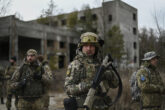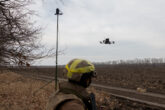May 23, 2022
How to Prepare for the Next Ukraine
It is too soon to predict how Russia’s brutal, unjustified war against Ukraine will end. But for now, it is clear that the Russian military has shockingly underperformed in the first phase of the war, whereas the Ukrainian military has punched far above its weight. Other revisionist powers contemplating aggression will be looking closely at Russia’s failings to avoid making the same mistakes, and the countries they threaten will be looking to Ukraine’s example for insight into how to fend off a larger, better-equipped adversary.
But there are also lessons for the United States. U.S. defense leaders need to consider what outcomes in Ukraine mean not only for how Washington assesses the military capabilities of adversaries in the future but also for how the United States and its allies can use asymmetric tactics to undermine those adversaries’ strengths and exploit their weaknesses. For example, militaries fielded under leaders who do not tolerate dissent or question assumptions will be vulnerable to a host of problems, from strategic miscalculation and inadequate logistics to poor battlefield command and troop morale. This is a systemic weakness of authoritarian regimes, but other states can also be susceptible. In addition, militaries that have not been tested in battle may struggle to train troops for the actual conditions they will face in war, to fight effectively as a joint force, and to adapt in real time to an adversary’s asymmetric tactics.
Washington should not wait until another powerful nation menaces a smaller neighbor to act on the lessons from this war.
Moscow’s war effort has been deeply flawed, but that is not the only reason Ukrainian forces have fared so well: they have been able to take advantage of Russian weaknesses thanks in part to the help they have received from the West. The remarkable performance of Ukraine’s military is a direct result of a multiyear security-assistance effort undertaken by the United States and its NATO allies since Russia’s 2014 invasion of Crimea. In those eight years, support in the form of equipment, training, and help with planning transformed the Ukrainian military into a far more capable fighting force. Over the past three months, unified Western assistance has made a difference on the battlefield, too. Dozens of countries have come together to share intelligence, offer military and economic aid, and impose severe economic and political costs on Russia.
In Ukraine, Washington now has a working model for strengthening the ability of its allies and partners to defend themselves and, possibly, to deter future conflict. It should not wait until another powerful nation menaces a smaller neighbor to act on the lessons from this war.
Read the full article from Foreign Affairs.
More from CNAS
-
Defense / Transatlantic Security
When Defense Becomes Destruction: Austria-Hungary’s Mistake and Ukraine’s RiskThis article was originally posted on War on the Rocks. The southeastern Polish city of Przemyśl, with its elegant 19th century Habsburg-era train station, remains one of the ...
By Franz-Stefan Gady
-
Defense / Transatlantic Security
Ukraine’s Catch-22 MomentThis article was originally published in the Financial Times. In Joseph Heller’s wartime classic, Catch-22, the protagonist Yossarian seeks out the US army surgeon Doc Daneeka...
By Franz-Stefan Gady
-
CNAS Insights | Budgetary Own Goals Undermine “Speed and Volume”
On November 7, Secretary of Defense Pete Hegseth laid out a plan to overhaul the Department of Defense’s (DOD’s) acquisition system. Placing an emphasis on delivering new capa...
By Philip Sheers, Carlton Haelig & Stacie Pettyjohn
-
Drones: Who Is Making the New Weapons of War?
From Ukraine and Russia to Gaza and Sudan, drones have become a key weapon of war. Which companies are making them, and profiting from this rapidly expanding but controversial...
By Stacie Pettyjohn




